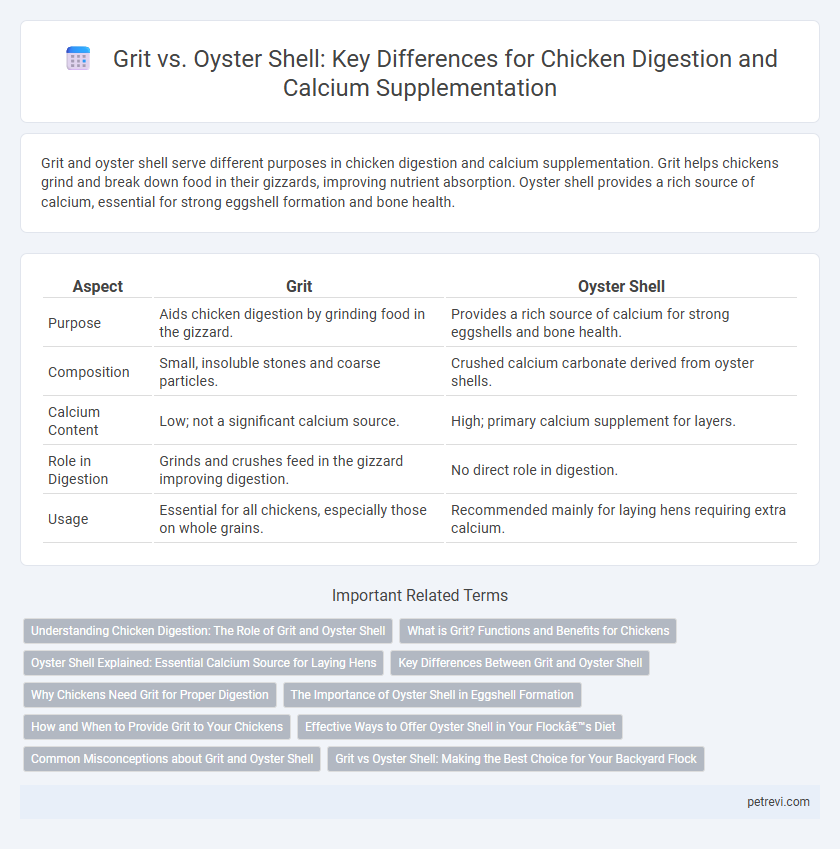Grit and oyster shell serve different purposes in chicken digestion and calcium supplementation. Grit helps chickens grind and break down food in their gizzards, improving nutrient absorption. Oyster shell provides a rich source of calcium, essential for strong eggshell formation and bone health.
Table of Comparison
| Aspect | Grit | Oyster Shell |
|---|---|---|
| Purpose | Aids chicken digestion by grinding food in the gizzard. | Provides a rich source of calcium for strong eggshells and bone health. |
| Composition | Small, insoluble stones and coarse particles. | Crushed calcium carbonate derived from oyster shells. |
| Calcium Content | Low; not a significant calcium source. | High; primary calcium supplement for layers. |
| Role in Digestion | Grinds and crushes feed in the gizzard improving digestion. | No direct role in digestion. |
| Usage | Essential for all chickens, especially those on whole grains. | Recommended mainly for laying hens requiring extra calcium. |
Understanding Chicken Digestion: The Role of Grit and Oyster Shell
Grit and oyster shell play essential roles in chicken digestion and calcium absorption, with grit aiding the mechanical breakdown of food in the gizzard and oyster shell providing a rich calcium source necessary for strong eggshell formation. Chickens lack teeth and rely on grit--small, hard particles like granite or quartz--to crush grains and seeds, facilitating nutrient extraction. Oyster shell, high in calcium carbonate, supports skeletal health and optimizes eggshell quality by supplying bioavailable calcium during egg production.
What is Grit? Functions and Benefits for Chickens
Grit is composed of small, coarse particles such as sand, granite, or crushed stone that chickens consume to aid in grinding food within their gizzards. It plays a crucial role in improving nutrient absorption and enhancing overall digestion by breaking down grains and fibrous materials. Using grit promotes better calcium utilization, supporting strong eggshell formation and optimal skeletal health in chickens.
Oyster Shell Explained: Essential Calcium Source for Laying Hens
Oyster shell is a vital calcium source for laying hens, providing the necessary minerals to support strong eggshell formation and overall bone health. Unlike grit, which aids in grinding food for digestion, oyster shell specifically supplies high levels of bioavailable calcium critical during the egg-laying cycle. Incorporating oyster shell into a hen's diet ensures optimal calcium intake, enhancing eggshell quality and reducing the risk of calcium deficiency-related issues.
Key Differences Between Grit and Oyster Shell
Grit consists of small, hard particles like crushed stone that aid chickens in grinding food in their gizzards, improving digestion. Oyster shell is a natural source of calcium carbonate, essential for strengthening eggshells and supporting bone health. While grit focuses on mechanical digestion, oyster shell primarily supplies calcium to meet laying hens' nutritional needs.
Why Chickens Need Grit for Proper Digestion
Chickens require grit to effectively grind and break down food in their gizzards, aiding proper digestion since they lack teeth. Unlike oyster shells that primarily supply calcium for strong eggshell formation, grit consists of small, hard particles such as granite or flint that mechanically process feed. Without grit, chickens cannot adequately digest grains and other tough materials, leading to poor nutrient absorption and overall health decline.
The Importance of Oyster Shell in Eggshell Formation
Oyster shell is a vital source of calcium, essential for strong eggshell formation in laying hens. Unlike grit, which aids mechanical digestion in the gizzard, oyster shell dissolves slowly, providing a steady calcium supply necessary for shell calcification. Adequate oyster shell supplementation prevents eggshell thinning and breakage, improving overall egg quality and hen health.
How and When to Provide Grit to Your Chickens
Provide grit to chickens before introducing them to whole grains or foraging outside, as grit aids in grinding food within their gizzards to improve digestion. Offer insoluble grit composed of small stones or granite regularly when chickens consume scratch grains, seeds, or natural forage to ensure effective nutrient absorption. Oyster shell should be given separately as a calcium supplement, typically during the laying period, while grit remains essential for mechanical digestion throughout a chicken's life.
Effective Ways to Offer Oyster Shell in Your Flock’s Diet
Oyster shell serves as a crucial calcium source for laying hens, enhancing eggshell strength and overall bone health. Offering oyster shell separately from regular feed ensures chickens consume adequate calcium without overfeeding grains or grit. Providing oyster shell free-choice in a separate feeder encourages natural selection, supporting optimal digestion and mineral intake in your flock.
Common Misconceptions about Grit and Oyster Shell
Many poultry keepers mistakenly believe grit and oyster shell serve the same purpose in chicken digestion and calcium supplementation. Grit primarily aids in mechanical digestion by grinding food in the gizzard, while oyster shell provides a crucial source of calcium for eggshell formation. Confusing these roles can lead to inadequate calcium intake or digestive issues in chickens, impacting their health and egg production.
Grit vs Oyster Shell: Making the Best Choice for Your Backyard Flock
Grit and oyster shell serve distinct roles in chicken digestion and calcium supplementation; grit helps grind food in the gizzard, improving nutrient absorption, while oyster shell provides a vital source of calcium essential for strong eggshell formation. Choosing the best option depends on your flock's diet: grit is essential if chickens consume whole grains or scratch feed, while oyster shell benefits laying hens needing extra calcium. Incorporating both ensures optimal digestive efficiency and robust egg production, promoting overall flock health.
Grit vs Oyster Shell for Chicken Digestion and Calcium Infographic

 petrevi.com
petrevi.com